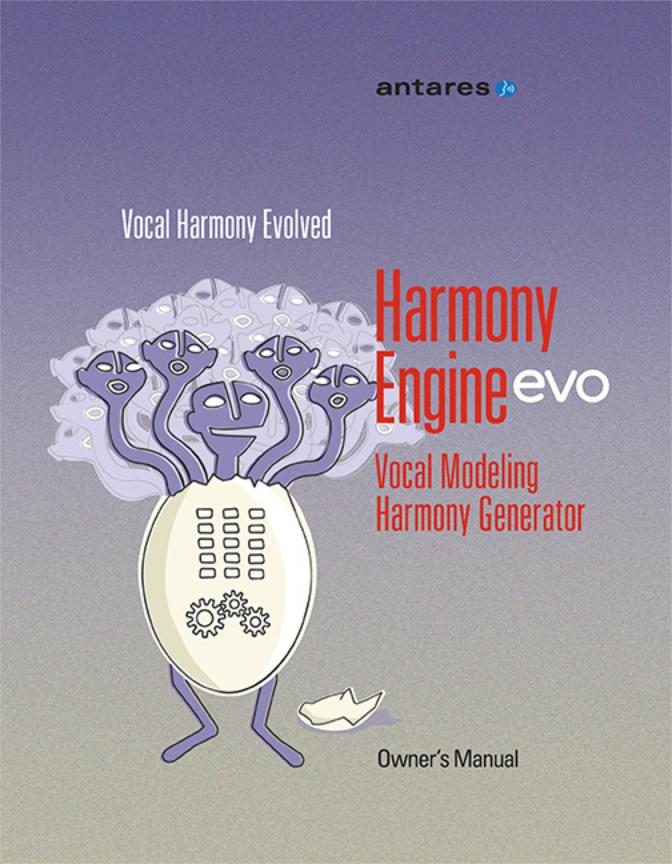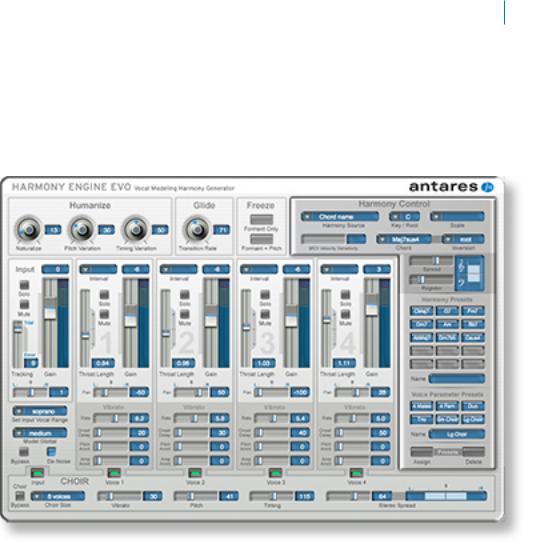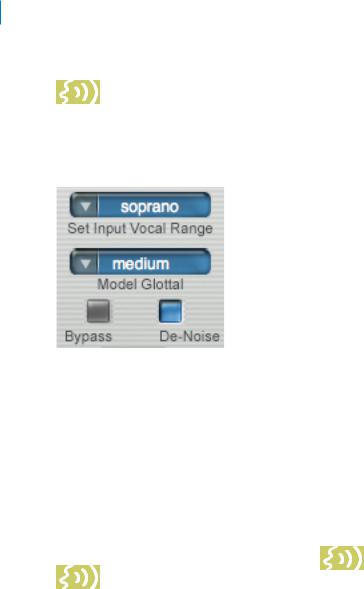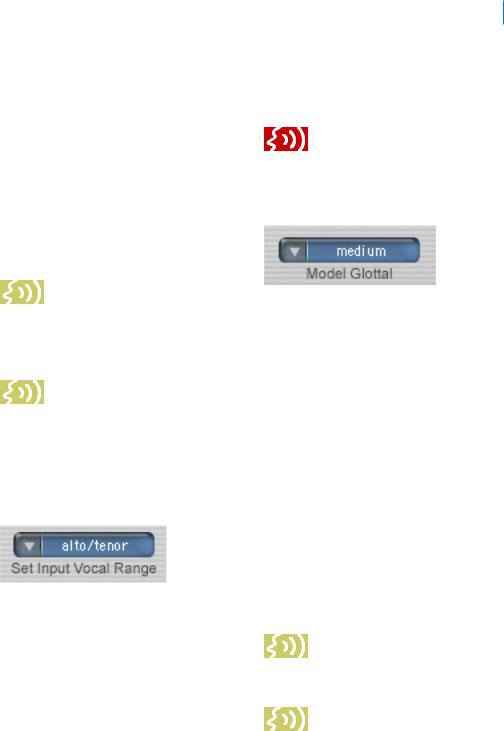ANTARES Harmony Engine Evo Owner’s Manual


Vocal Modeling
Harmony Generator
Owner’s Manual
©2009 Antares Audio Technologies.
All rights reserved. Certified Isinglass-free.™
All trademarks are property of their respective owners. Antares Audio Technologies
231 Technology Circle, Scotts Valley, California 95066 USA www.antarestech.com
Printed in USA Rev 1.0 PN P25032-0109-M01
The Obligatory Legal Mumbo-Jumbo
The Antares Harmony Engine Evo software and this User’s Manual are protected by copyright law. Making copies, adaptations, or derivative works without the prior written authorization of Antares Audio Technologies, is prohibited by law and constitutes a punishable violation of the law.
Antares Audio Technologies retains all ownership rights to the Harmony Engine Evo software and its documentation. Use of Harmony Engine Evo is limited by the following license agreement.
Please carefully read all the terms and conditions of this license agreement. At the time of installation of the Harmony Engine Evo software you will be presented with a copy of the agreement and asked whether or not you agree to it. Continuing with the installation process beyond that point constitutes such agreement.
Harmony Engine Evo License Agreement
Antares Audio Technologies grants you a non-transferable, non-exclusive license to use Harmony Engine Evo under the terms and conditions stated in this agreement. Use of Harmony Engine Evo indicates your agreement to the following terms and conditions.
License
You may:
1.Use Harmony Engine Evo on only one computer at a time.
You may not:
1.Make copies of Harmony Engine Evo or of the user manual in whole or in part except as expressly provided for in this agreement. Your right to copy Harmony Engine Evo and the user manual is limited by copyright law. Making copies, verbal or media translations, adaptations, derivative works, or telecommunication data transmission
of Harmony Engine Evo without prior written authorization of Antares, is prohibited by law and constitutes a punishable violation of the law.
2.Make alteration or modifications to Harmony Engine Evo (or any
copy) or disassemble or de-compile Harmony Engine Evo (or any copy), or attempt to discover the source code of Harmony Engine Evo.
3.Sub-license, lease, lend, rent, or grant other rights in all or any portion of Harmony Engine Evo (or any copy) to others.
Term of the Agreement
This agreement is effective until terminated by you or Antares. You may terminate the
agreement at any time by notifying Antares and destroying all copies of the manual, and erasing Harmony Engine Evo from all machine-readable media, whether on-line or on archival copies.
In the event of breach of any of the terms of this agreement, you shall pay the attorney’s fees of Antares that are reasonably necessary to enforce the agreement plus resulting damages.
Limited Warranty And Disclaimer
Harmony Engine Evo AND ACCOMPANYING MATERIALS ARE PROVIDED “AS IS” WITHOUT WARRANTY OF ANY KIND, EITHER EXPRESS OR IMPLIED, INCLUDING, BUT NOT LIMITED TO, THE IMPLIED WARRANTIES OF MERCHANTABILITY AND FITNESS FOR A PARTICULAR PURPOSE.
Antares Audio Technologies does not warrant that the functions contained in the program will meet your requirements. The entire risk as to the use, quality, and performance of Harmony Engine Evo is with you.
SOME JURISDICTIONS DO NOT ALLOW LIMITATIONS ON HOW LONG AN IMPLIED WARRANTY LASTS, SO THE ABOVE LIMITATION MAY NOT APPLY TO YOU. THIS WARRANTY GIVES YOU SPECIFIC LEGAL RIGHTS. YOU MAY ALSO HAVE OTHER RIGHTS WHICH VARY FROM JURISDICTION TO JURISDICTION.
Limitation of Liability
IN NO EVENT WILL ANTARES BE LIABLE FOR ANY DAMAGES, INCLUDING LOSS OF DATA, LOST PROFITS OR OTHER SPECIAL, INCIDENTAL, CONSEQUENTIAL OR INDIRECT DAMAGES ARISING FROM THE USE OF
Harmony Engine Evo OR ACCOMPANYING MATERIALS. THIS LIMITATION WILL APPLY EVEN IF ANTARES OR ITS AUTHORIZED AGENT HAS BEEN ADVISED OF THE POSSIBILITY
OF SUCH DAMAGE. YOU ACKNOWLEDGE THAT THE LICENSE FEE REFLECTS THIS ALLOCATION OF RISK. SOME JURISDICTIONS DO NOT ALLOW LIMITATION OR EXCLUSION OF LIABILITY FOR INCIDENTAL OR CONSEQUENTIAL DAMAGES, SO THE ABOVE LIMITATION MAY NOT APPLY TO YOU.
Whew! Now that that’s over, let’s get on to the good stuff.
Contents
Chapter 1 |
Getting Started |
|
|
How to use this manual |
3 |
|
Installing and Authorizing |
4 |
|
Technical Support |
4 |
Chapter 2 |
Introducing Harmony Engine Evo |
|
|
What the heck is this thing? |
5 |
Chapter 3 |
Harmony Engine Evo Controls |
|
|
Controls |
7 |
|
Setup |
8 |
|
Original Input |
10 |
|
Harmony Voices |
12 |
|
Vibrato Controls |
15 |
|
Humanization |
16 |
|
Glide |
17 |
|
Freeze |
17 |
|
CHOIR |
18 |
|
Harmony Control |
20 |
|
Harmony Presets |
29 |
|
Voice Parameter Presets |
31 |
Chapter 4 |
The Factory Presets |
|
|
The Presets |
33 |
Chapter 5 |
Tutorials |
|
|
Stay By Me |
40 |
|
Lift Us Away |
41 |
|
Let You Know |
43 |
Index |
|
45 |

vi

1
Welcome!
On behalf of everyone at Antares Audio Technologies, we’d like to offer both our thanks and congratulations on your decision to purchase Harmony Engine Evo, the second generation of the quickest, easiest to use tool for realistic harmony creation. Before you proceed any farther, we’d like to strongly encourage you to register
and authorize your copy of Harmony Engine Evo. (You can skip ahead to the Authorization and Installation instructions on page 3. We’ll wait.)
As a Harmony Engine Evo owner, you are entitled to receive notification of any software upgrades, technical support, and advance announcements of upcoming products. But we can’t send you stuff unless we know who and where you are. So please, register.
With your purchase of Harmony Engine Evo, you have created a relationship with Antares which we hope will be long and gratifying. Let us know what you think. You can count on us to listen.
Again, thanks.
The Whole Antares Crew

2

3
Chapter 1: Getting Started

 How to use this manual
How to use this manual
We know you’re probably anxious to get some
harmony going. While we’ve designed the Harmony Engine Evo interface to be largely self-explanatory, Harmony Engine Evo introduces some entirely new concepts to the process of quickly and easily creating realistic harmonies, so, to really get the most out of Harmony Engine Evo, we strongly encourage you to read this manual.
Of course, you’re welcome to just launch your host and play around with Harmony Engine Evo for a while, but to get a good idea of Harmony Engine Evo’s capabilities (and how to accomplish various basic tasks) you should at least check out Chapter 4, Factory Presets. We’ve included a variety of presets that configure Harmony Engine Evo to let you quickly and easily interact with its various modes and functions. Then check out Chapter 5, Tutorial Sessions, where you can see (and hear) exactly how Harmony Engine Evo was used to create some of the audio demos on our web site and installation DVD ROM. The demos’ composers have been kind enough to allow us to include the actual sessions for you to load into your host and experiment with. Open them up. Check out the Harmony Engine Evo settings. Tweak some controls and see what happens.
Finally, when you’re ready to learn everything Harmony Engine Evo can do, check out Chapter 3 for detailed descriptions of every function.
The contents of this manual
Chapter 1: Getting Started
The chapter you are reading. Provides information on installing and authorizing Harmony Engine Evo.
Chapter 2: Introducing Harmony Engine Evo
Provides a brief introduction to what Harmony Engine Evo is all about and gives an overview of Harmony Engine Evo’s key features.
Chapter 3: Harmony Engine Evo Controls
This chapter is reference information for every control used in the Harmony Engine Evo interface.
Chapter 4: The Factory Presets
Descriptions of the factory presets that ship with Harmony Engine Evo.
Chapter 5: Tutorial Sessions
Describes the complete host sessions provided as hands-on examples of how Harmony Engine Evo is used.

4
Installing Harmony Engine Evo
Harmony Engine Evo is designed to function as a plug-in in a wide variety of digital audio applications. Please refer to your specific host application’s user manual for more information on installing and using plug-ins.
Authorizing Harmony Engine Evo
Authorization is the process by which Harmony Engine Evo is allowed to run on your computer. Detailed instructions covering the available authorization options will be found in the file “Authorization Read Me” which is included on the installation CD ROM or with your software download.
NOTE: When initially installed, this software will run for ten days without authorization.
So even if you can‘t authorize it right away you can still use your software in the meantime. (During this period, click the “Continue” button whenever you are presented with the Trial Period screen at launch.) But don’t procrastinate too long. After those ten days are up you will no longer be able to launch Harmony Engine Evo until it’s authorized.
Technical Support
In the unlikely event that you experience a problem using Harmony Engine Evo, try the following:
1.Make sure you have the latest version of the plug-in. You can download and install the latest version of Harmony Engine Evo from the following web page:
http://www.antarestech.com/download/
update.shtml
2.If you are having problems authorizing your software, be sure that you have the latest version of the PACE Interlok drivers. You can download and install the latest version for your operating system from the following web page:
http://portal.knowledgebase.net/article.
asp?article=174703&p=5764
If your problem is not resolved after taking the above actions, try the following:
1.Make another quick scan through this manual. Who knows? You may have stumbled onto some feature that you didn’t notice the first time through.
2.Consult our searchable knowledgebase at:
http://www.antarestech.com/support/
index.html
3.Check our web page for tips, techniques, or any late-breaking information: http://www.antarestech.com

5
Chapter 2:
Introducing Harmony Engine Evo
What the heck is this thing?
Harmony Engine Evo is the second generation of our Harmony Engine real-time harmony generating plugin. Like its predecessor, Harmony Engine Evo puts professional-quality vocal harmony
arrangements within reach of any songwriter, producer, musician or engineer.
What’s new?
While clearly the most visible addition to Harmony Engine Evo is the integration of five channels of our unique CHOIR Vocal Multiplier (and that is seriously cool), the real story is tucked away invisibly under the hood (so to speak).
During the development of Auto-Tune Evo, the latest version of the worldwide standard in professional pitch correction, Dr. Andy went back to the proverbial drawing board to create a seriously evolved voice processing technology that takes advantage of the hugely more powerful computers that are now the norm for digital audio recording.
The result was Evo™ Voice Processing Technology, setting a new standard for pitch detection, pitch shifting, and throat modeling that is substantially more accurate and reliable over a much wider range of audio input quality.
Now we’ve turned our attention to incorporating Evo Technology into Harmony Engine. The result is an entirely new level of sonic performance. With faster, more accurate pitch detection, smoother, artifact-free pitch shifting, and seamless, natural-sounding (if you want it to be) throat modeling, Harmony Engine Evo just works better. Leaving you free to focus on creating your music.
What’s it do?
Traditionally, harmony tools offer two basic operating modes:
On one hand are fully automatic modes based on either parallel or “smart” scale-based intervals. These are relatively easy to set up, but offer very little in the way of creative control.
On the other hand (assuming organisms with two hands) are MIDI modes that provide control of each individual note of each individual harmony voice. While these techniques offer absolute control, they also demand that you be skilled in the intricacies of vocal arranging (as well as having the time and patience to enter every note into a MIDI track, hardly a trivial undertaking).
With Harmony Engine Evo, we set ourselves the task of creating a tool that would let anyone who could hear the harmonies they wanted in their mind quickly and easily create those harmonies in a song or other project. While Harmony Engine Evo offers all of the traditional harmony generation methods, it adds a variety of new operating paradigms that allow you to approach the harmony generation process from a purely musical point of view.
What’s it got?
With four independent harmony voices utilizing our advanced Evo™ Voice Processing Technology, a variety of powerful harmony generating modes, humanization features
for natural sounding performances, a flexible real-time preset system for harmony and vocal type, and five integrated channels of Antares’ unique CHOIR Vocal Multiplier, Harmony Engine Evo provides incredibly easy-to-use tools to quickly and easily produce virtually any vocal arrangement you can imagine.

6
Key Harmony Engine Evo features include:
•Four high-quality, formant-corrected harmony voices featuring Evo™ Voice Processing Technology providing independent vocal character, vibrato, and pan settings
•Antares Throat Modeling technology that lets you process each harmony voice through a physical model of the human vocal tract
•A variety of innovative Harmony Control modes, from fully automatic to individual control of every note:
Fixed or Scale Intervals: Simply set the key and harmony voice intervals and let Harmony Engine Evo do the rest
Scale Degree or Chord Name: Define your harmony chord-by-chord, complete with inversions and variable vocal ranges
Chord by MIDI: Define your harmony in real time via a MIDI controller or prerecorded MIDI track
MIDI Omni: Directly “play” the four harmony voices as if they were voices of a synth or sampler.
MIDI Channel: Use four separate MIDI channels for absolute control over each note of your vocal arrangement
•Spread and Register controls that allow you to quickly and intuitively set the pitch range and harmony style of your vocal arrangement
•Humanize functions that provide selectable amounts of variation to each harmony voice for realistic, natural sounding results
•A Freeze function that allows a unique variety of backup vocal effects by letting you instantly freeze pitch and/or formant articulation
•A Harmony Preset matrix that lets you create up to 15 complete harmony settings and instantaneously recall them, in real time or via automation
•A Voice Parameter Preset matrix that lets you create and instantly recall up to 6 different “vocal groups”
•Five integrated channels of our unique CHOIR Vocal Multiplier, to let you turn the input voice and/or each harmony voice into 2, 4, or 8 distinct individual unison voices, each with its own pitch, timing and vibrato variations. Perfect for creating entire choirs out of a single vocal line.
•Five-channel output capability (host dependent) that lets you assign the original input and each of the four harmony voices to their own channels for further processing
Whether you’re an experienced vocal arranger, a songwriter looking for that perfect backup vocal, or a composer experimenting with unique vocal effects, Harmony Engine Evo gives you entirely new ways to create the harmony parts you hear in your head. In fact, experimenting with different harmonies is so easy (and, dare we suggest, fun), you may find yourself using Harmony Engine Evo to explore harmonic alternatives you may have never otherwise considered.
Harmony Engine Evo is, quite simply, the quickest, easiest tool for flexible, realistic harmony creation.

7
Chapter 3: Harmony Engine Evo Controls
This chapter is a reference for all of the controls used in the Harmony Engine Evo interface.
Controls
Continuous controls in Harmony Engine Evo are represented by virtual knobs or faders.
Knobs can be controlled by either vertical or horizontal movement:
VERTICAL: Position the cursor over a knob, press and hold the left mouse button (or the only mouse button, if you’re using a one-button mouse) and move the cursor up to turn the knob clockwise or down
to turn the knob counterclockwise. The current value of the knob’s parameter appears in its associated numeric display.
HORIZONTAL: Position the cursor over a knob, press and hold the left mouse button and move the cursor to the right to turn the knob clockwise or to the left to turn the knob counterclockwise. The current value of the knob’s parameter
appears in its associated numeric display.
For faders, simply click on the “thumb” of the fader and move it to the desired setting.
Option (Mac)/Control (PC)-clicking a control returns it to its default value.

8
Note: The specific modifier key may vary from host to host (Steinberg hosts on the Mac, for example, use
the Command (Apple) key instead of the Option key). Refer to the Harmony Engine Evo Read Me for details (or just try a few until you find the one what works).
Setup
The functions described in this section are used to tell Harmony Engine Evo things about the source audio or otherwise affect the plug-in as a whole.
Input Audio
For accurate harmony generation and best modeling performance, Harmony Engine Evo needs to be able to detect the pitch of the original performance. To do that, Harmony Engine Evo requires a clean,
pitched, monophonic signal. (In this context, “clean” refers both to lack of noise and lack of processing with effects like chorus, reverb, etc.)
Note: Keep in mind that the input must not only be monophonic, but actually a solo voice or instrument
(as opposed to a unison section). For example, a group of singers singing the same note will typically not be reliably tracked.
You can have problems with certain solo voices and solo instruments as well. Consider, for example, an exceptionally breathy voice, or a track recorded in an unavoidably noisy environment. The added noise is non-periodic and Harmony Engine Evo will have difficulty determining the pitch of the composite
(voice + noise) sound. Luckily, there is a control (the Tracking control, discussed later in this chapter) that will let Harmony Engine Evo be a bit more casual about what it considers “periodic.” Experimenting with this setting will often allow Harmony Engine Evo to track even noisy signals.
Routing
Harmony Engine Evo should typically be instantiated as an insert effect on the track that will supply the source audio. Harmony Engine Evo can be instantiated on a mono or stereo track, but since it processes only a single channel of audio, if you instantiate it on a stereo track, the two channels will be mixed together before being processed.
Harmony Engine Evo’s output can be mono or stereo (or, in some circumstances, five channels — see below). Unless you have some overriding reason for using a mono
output, we highly recommend using it in stereo output mode, since in mono mode, all panning controls are disabled. This prevents you from positioning the harmony voices across the stereo soundstage and dramatically impacts (in a not-so-swell way) the overall effect.
Effects
The cleaner the input signal, the easier Harmony Engine Evo’s task of reliably detecting its pitch. For this reason, effects designed to improve the quality of the input (e.g., de-essing, noise reduction, etc.) should be applied to the audio before it is input to Harmony Engine Evo.
Note: If you will be using both de-essing and compression on your vocal track, it has been our
experience that using the de-esser before the compressor provides improved results in Harmony Engine Evo.
As mentioned above, effects like chorus or reverb can negatively affect Harmony Engine Evo’s ability to reliably detect the pitch of the input audio. As a result, you should not apply these effects to the input audio before it is routed into Harmony Engine Evo. Either apply them to the Harmony Engine Evo output or, if you only want them on the original audio, apply them to a copy of the original audio on

9
another track and then mute the original input in Harmony Engine Evo.
Five Channel Output
Depending on your host’s routing capabilities, you may be able to use Harmony Engine Evo in five channel output mode to send the original input and the four harmony voices
to five separate channels for subsequent individual processing. Unfortunately, the ability and method of accomplishing this varies from host to host and typically involves making nonstandard use of a host’s 5.1 capabilities. Check your host’s manual and the Harmony Engine Evo Read Me for details.
Note: While it is our intention to provide tips in our Knowledgebase on using five channel output in the major
hosts that support it, your primary resource should be a detailed knowledge of how routing works in your host. In this case, your host’s manual is your best friend.
Another Note: With the original Harmony Engine, we felt that one of the most useful (and dramatic)
reasons to use five channel output was to allow you to use instances of CHOIR or DUO on each of the individual channels. With the integration of CHOIR into Harmony Engine Evo, it’s no longer necessary to struggle with five channel routing to get those effects, so it may well be that you can just ignore this whole issue.
Set Input Vocal Range
As a result of Antares’ research
into the unique characteristics of various types of audio signals, Harmony Engine Evo offers a selection of optimized processing algorithms for the most common types of inputs. Choices include Soprano Voice, Alto/Tenor Voice, Bass/ Baritone Voice and Instrument (a general setting for anything that isn’t actually a vocal). Matching the appropriate algorithm to the input results in faster and more accurate pitch detection and more accurate modeling.
To select vocal range, click on the Vocal Range pop-up and then select the appropriate range from the pop-up list.
Important Note: We really can’t stress this enough. Getting this setting right is critical to getting the
best performance from Harmony Engine Evo. Choosing the wrong Vocal Range (or just forgetting to set it at all) will result in compromised performance. Pay attention.
Model
Glottal
The glottal waveform is created by the
vibration of a singer’s vocal chords. While the glottal waveform is largely defined by each singer’s individual anatomy, it is also affected by the specific singing style of a particular performance. For example,
singing softly results in a markedly different glottal waveform than does belting a
song with great energy and volume.
The Model Glottal control lets you tell Harmony Engine Evo what performance style you would like to model. The options are soft, medium, loud, and intense. (If you want to preserve the stylistic character of the original vocal, start with this control set to Medium.)
Despite the value names (soft, loud, etc.), these settings result in only modest change to the actual level of the signal (with the “intense” setting providing the most gain). Its primary purpose is to model the glottal waveform that would result from the various styles of singing. If you want to further adjust the levels, use
the individual Harmony Voice Gain controls described below.
Note: The Model Glottal control affects all of the harmony voices. To define individual vocal characteristics
for each voice, use the Throat Length controls described later in this chapter.
Another Note: The Model Glottal control does not affect the Original Input.
